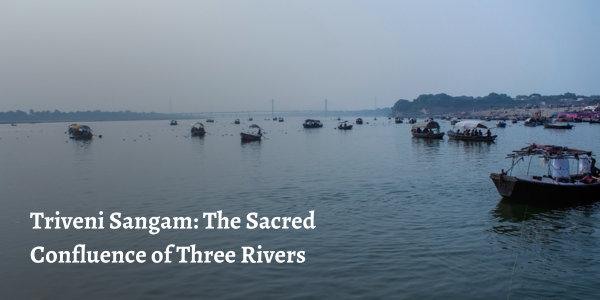Triveni Sangam: The Sacred Confluence of Three Rivers
Triveni Sangam is a most sacred place, located at Prayagraj in Uttar Pradesh, where the three significant rivers of India converge: the Ganga, the Yamuna, and the mythological Saraswati. The Sangam or the confluence of these three rivers is more than just a geographical occurrence; it is a heartland and, above all, has immense religious value in Hinduism. This holy place is thronged by pilgrims, seekers, and tourists, so a must-visit destination for rejuvenation of the soul as well as cultural exploration.
The Holy Confluence
Triveni Sangam is the confluence of three rivers, each of which has its special spiritual significance. Ganga is a goddess of purification and thus is a symbol of life and liberation. Yamuna, who symbolizes compassion and love, adds to the sanctity of Ganga. Saraswati, invisible and flowing underground, signifies wisdom and enlightenment. The confluence of these rivers is not only a physical phenomenon but also a metaphor for the spiritual union of body, mind, and soul.
The most striking feature of the confluence is the visibly evident distinction between the rivers. The pale, muddy waters of the Ganga mix with the greenish tinge of the Yamuna to create a very interesting play of colors. The Saraswati is unseen but deeply revered, and an aura of mystery and divinity surrounds the Sangam.
Mythological Significance
According to Hindu mythology, Triveni Sangam is said to be a sacred tirtha or spiritual crossing point where the heavens and earth meet. It is said that bathing in the waters of the Sangam will cleanse one of sins and lead to moksha, liberation from the cycle of birth and death. According to myth, it is also said that some of the amrit or nectar of immortality spilled during the celestial event of Samudra Manthan at this place.
The mythical presence adds another layer of spiritual depth to it. It is said to heighten knowledge, remove ignorance, and confer divine blessings to the visitor. Thus, the water of the Sangam can be considered not only a source for the purification of the body but also a passage for transubstantiation.
Kumbh Mela and Rituals
Triveni Sangam is the center point of Kumbh Mela, one of the world’s largest spiritual congregations.The grand festival occurs once in 12 years, attracting millions of devotees, saints, and ascetics to gather to take a holy dip in the waters of Sangam. Ritual bath is called “Snan,” believed to wash all sins and provide spiritual elevation.
It is also a venue for many religious ceremonies, including pins daan and asthi visarjan. Pind daan and asthi visarjan are a belief strongly ingrained in people that the sacred waters of Sangam take the mantras and offerings to God.
It’s as if the very banks of the Sangam get to life with devotional and festive fervour, at Kumbh Mela. Temporary camps, ashrams and dais for spiritual discourses rise from the ground; there was the added mystique with saffron robes and ash smeared sadhus or the holy men.
A Destination of Serenity and Splendor
Visiting Triveni Sangam is not a journey but an experience beyond the physical act of travel. It is a journey into the heart of Indian spirituality and culture. A short boat ride takes one to the site, with gentle lapping of the waters against the boat, thus giving a serene experience. The confluence point is indeed a sight to behold-the two rivers visibly merging into each other against the vast sky.
Triveni Sangam is very beautiful in the golden hue of sun or sunset. This view looks totally breathtakingly quiet at a time when temple bells filled the air, the sweet fragrance of devotional songs and continuous rhythmic chanting by priests or devotees. History and Culture Significance
Century back Triveni Sangam became a witness to history and culture and finds its mention in Veds, Purans, inspires poets, saints, philosophers. The ashes of most important leaders have been submerged here; hence, in fact, it is a treasure house of Indian history.
It has also been an inspiration to photographers, writers, and artists. Spiritual and natural beauty offers the site an enduring charm, and during festivals, with this serene surroundings, gives it a unique energy and peace.
Conclusion
Triveni Sangam is much more than a point of confluence of rivers; it is a convergence of faith, culture, and history. It is an abiding symbol of the spiritual essence of India, which attracts millions of people, seeking solace, purification, and enlightenment. From being a pilgrim seeking wisdom to becoming a traveler who wants to go through India’s rich heritage, Triveni Sangam is an experience that will be both enrichingly deep and profoundly moving. It is a place where one may feel that the divine exists, where waters whisper the secrets of old times, and where each visitor goes out with a heart full of peace and devotion.


